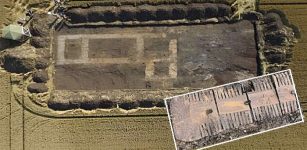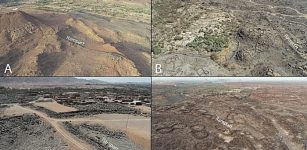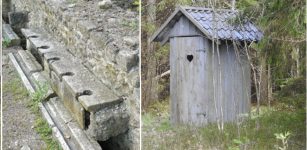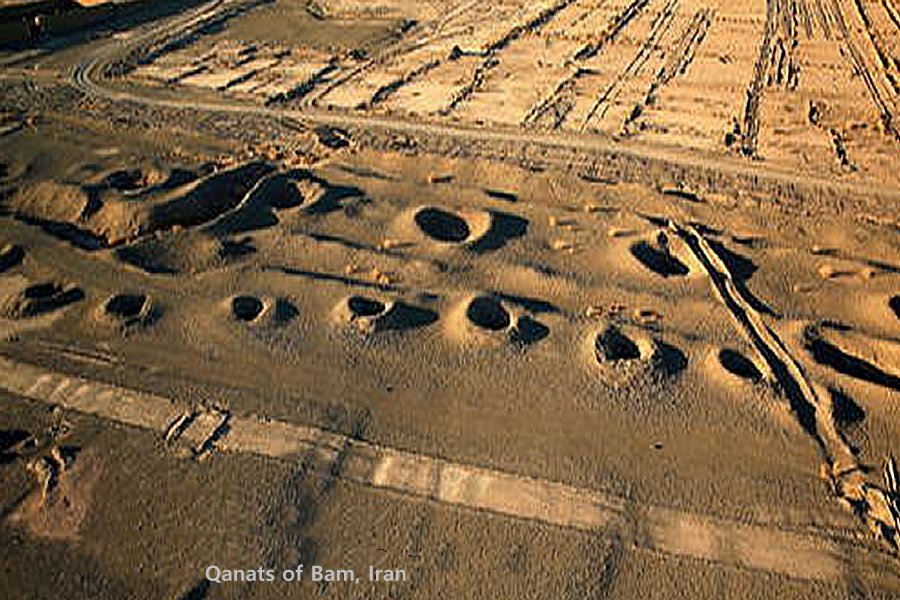Qanats: Ancient 3,000-Year-Old Underground Irrigation Canals Invented By People Of Persia
A. Sutherland - AncientPages.com - One of the ancient times' most amazing technologies is underground irrigation canals known as "qanats."
The qanats transported water from water wells to the surface for irrigation and drinking, and they could do it over long distances.
The technology- dated back more than 3000 years - was developed in ancient Persia. In the early part of the first millennium BC, Persians began to construct complex tunnel systems called 'qanats' for extracting groundwater in the dry mountain basins of present-day Iran. Later, the qanats gradually spread, and many of them are continuously in use stretching from China on the east to Morocco on the west, and even to both American continents. In fact, about 20,000 other qanats are still in use.
Qanat tunnels - often several kilometers long - were hand-dug, and their size was just large enough to fit the person doing the digging. Qanat builders sank vertical shafts along the tunnel at intervals of 20 to 30 meters. This space was needed to remove excavated material and to provide ventilation and access for future repairs.
The ancient Persian qanat water delivery system proved to have many apparent advantages. For example, it limited water loss from seepage and evaporation, and no pumps were necessary because the qanat system could function based entirely on gravity.
One of the longest known qanats in the world that is 70 km long is located in Iran. The qanat in the city of Gonabad ("Qanats of Gonabad"), which is the oldest and largest, is part of the Unesco World Heritage List since 2007. Built between 700 and 500 BC by the Achaemenid Empire in what is now Gonabad, Razavi Khorasan Province, Iran, the complex contains 427 water wells with a total length of 33,113 meters (20.575 mi).
Today, Gonabad's qanat provides water to more than 40,000 people.
With the conquests of the Persians, the qanats expanded from Egypt to Bactria (in modern times, certain parts of Tajikistan, northern Afghanistan, and southern Uzbekistan.
Many others can be found in the north of Africa, in the Middle East, China India, as well as in Sicily, in the southern parts of Spain and in the Canaries.
With this ancient technology, the Persians could build a set of vertical wells. It was important to dig them on a hill to reach a source of underground water. Then, the secondary wells connected the tunnel with the surface and finally, irrigation channels carried the water to respective areas.
The qanats significantly contributed to the prosperity and good life of the Persian people in regions exposed to bad weather conditions.
The vertical wells allowed access and help to ventilate the entire system. The wells are connected to a drainage gallery that is somewhat inclined, which helps water to descend in the form of waterfalls.
The qanats still create a reliable supply of water for human settlements and irrigation in hot, arid, and semi-arid climates.
Written by – A. Sutherland AncientPages.com Staff Writer
Updated on November 5, 2022
Copyright © AncientPages.com All rights reserved. This material may not be published, broadcast, rewritten or redistributed in whole or part without the express written permission of AncientPages.com
More From Ancient Pages
-
 Tomte – A Beloved Scandinavian Christmas Gnome
Christmas Traditions | Dec 24, 2024
Tomte – A Beloved Scandinavian Christmas Gnome
Christmas Traditions | Dec 24, 2024 -
 Why Are There No Unicorn Fossils In A Museum?
Archaeology | Mar 17, 2023
Why Are There No Unicorn Fossils In A Museum?
Archaeology | Mar 17, 2023 -
 Unexpected And Surprising Results Of Ancient DNA Study – Who Were The First People In South America?
Archaeology | Nov 2, 2022
Unexpected And Surprising Results Of Ancient DNA Study – Who Were The First People In South America?
Archaeology | Nov 2, 2022 -
 Benin Bronze Sculpture Looted By British Soldiers In Nigeria – Returns Home
Archaeology | Apr 2, 2021
Benin Bronze Sculpture Looted By British Soldiers In Nigeria – Returns Home
Archaeology | Apr 2, 2021 -
 Strange Ancient Mechanical Flying Animals – Myths Or Advanced Ancient Technology? – Part 1
Ancient Mysteries | Mar 25, 2020
Strange Ancient Mechanical Flying Animals – Myths Or Advanced Ancient Technology? – Part 1
Ancient Mysteries | Mar 25, 2020 -
 Mysterious Water Source Belonging To The Goddess Of The Cold Kingdom Of Evil Remains An Archaeological Puzzle
Ancient Mysteries | Dec 6, 2019
Mysterious Water Source Belonging To The Goddess Of The Cold Kingdom Of Evil Remains An Archaeological Puzzle
Ancient Mysteries | Dec 6, 2019 -
 Ancient Gaziantep Castle Destroyed In Turkey Earthquake
News | Feb 6, 2023
Ancient Gaziantep Castle Destroyed In Turkey Earthquake
News | Feb 6, 2023 -
 Mysterious Magical Healing Gift Of The Whisperers – Meet The Enigmatic Szeptunka
Featured Stories | Feb 10, 2025
Mysterious Magical Healing Gift Of The Whisperers – Meet The Enigmatic Szeptunka
Featured Stories | Feb 10, 2025 -
 Lincolnshire’s Prehistoric Henge And A Sacred Site Dating Back Hundreds Of Years
Archaeology | Apr 6, 2024
Lincolnshire’s Prehistoric Henge And A Sacred Site Dating Back Hundreds Of Years
Archaeology | Apr 6, 2024 -
 Calakmul Was Powerful Ancient Maya Seat Of The Snake Kingdom
Featured Stories | Apr 15, 2019
Calakmul Was Powerful Ancient Maya Seat Of The Snake Kingdom
Featured Stories | Apr 15, 2019 -
 Ancient DNA Solves The Mystery Of Mitochondrial Eve And Human Evolution?
Archaeology | Sep 21, 2022
Ancient DNA Solves The Mystery Of Mitochondrial Eve And Human Evolution?
Archaeology | Sep 21, 2022 -
 Vast Fortification Enclosing Walled Oasis Dating Back 4,000 years In North-Western Arabia – Unearthed
Archaeology | Jan 10, 2024
Vast Fortification Enclosing Walled Oasis Dating Back 4,000 years In North-Western Arabia – Unearthed
Archaeology | Jan 10, 2024 -
 Prehistoric Surgery: Skull Operations Technically Superior To Our Own
Ancient Mysteries | Dec 24, 2014
Prehistoric Surgery: Skull Operations Technically Superior To Our Own
Ancient Mysteries | Dec 24, 2014 -
 Mystery Of Egyptian Queen Hetepheres I’s Bracelets Solved!
Archaeology | Jun 2, 2023
Mystery Of Egyptian Queen Hetepheres I’s Bracelets Solved!
Archaeology | Jun 2, 2023 -
 Beer Was Used As Medicine And Payment In Ancient Egypt
Ancient History Facts | Feb 11, 2018
Beer Was Used As Medicine And Payment In Ancient Egypt
Ancient History Facts | Feb 11, 2018 -
 850,000-Year-Old Remains Of Homo Antecessor Found At Atapuerca, Spain
Archaeology | Jul 30, 2024
850,000-Year-Old Remains Of Homo Antecessor Found At Atapuerca, Spain
Archaeology | Jul 30, 2024 -
 How Did People Go To The Toilet In The Past Before The Invention Of The Flush Toilet?
Archaeology | Jun 10, 2023
How Did People Go To The Toilet In The Past Before The Invention Of The Flush Toilet?
Archaeology | Jun 10, 2023 -
 The Egyptian Dream Book Reveals Ancient Predictions Of The Future
Egyptian Mythology | Jun 6, 2020
The Egyptian Dream Book Reveals Ancient Predictions Of The Future
Egyptian Mythology | Jun 6, 2020 -
 Why Do Old Norse Myths Endure In Popular Culture?
Featured Stories | Mar 16, 2023
Why Do Old Norse Myths Endure In Popular Culture?
Featured Stories | Mar 16, 2023 -
 Did Climate Change End The Akkadian Empire?
Civilizations | Jul 17, 2019
Did Climate Change End The Akkadian Empire?
Civilizations | Jul 17, 2019



